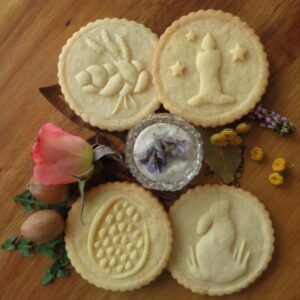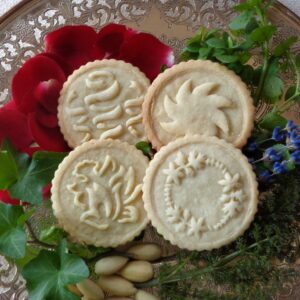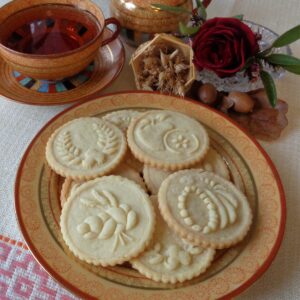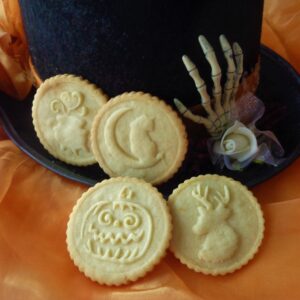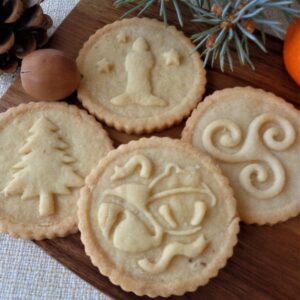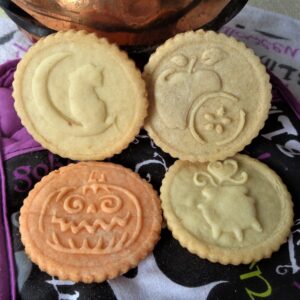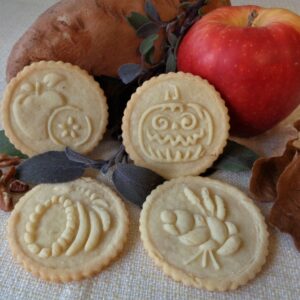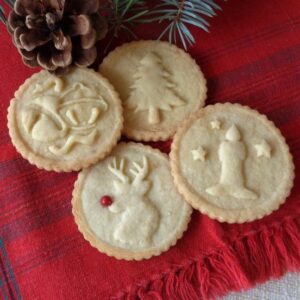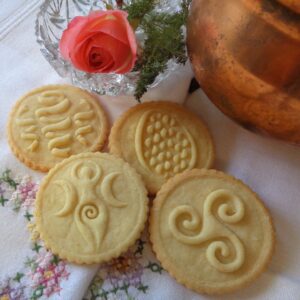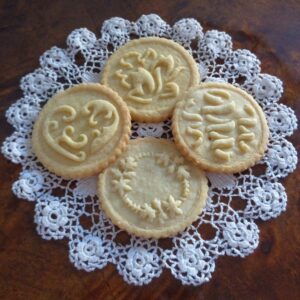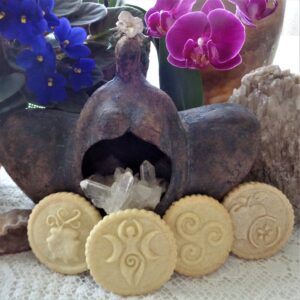Celebrations often include that little something extra. The festive images from a variety of traditions and stories are captured in cookies made with My Kitchen Wand stamps. We want your experience of cookie stamps to go well. To that end please, please read this page on how to get the best results with My Kitchen Wand cookie stamps.
After the pictures are short explanations of the twenty designs currently in the cookie stamp collection. Please note that short might also be interpreted as incomplete because time and history always gives layers of complexity to any discussion of these symbols.
If the history of imprint cookies is your thing, then enjoy the last section at the bottom this page.
The first grouping of six is connected to the Wheel of the Year. The second grouping connect more to the calendar as we know it today and the last group contain selections by theme. We hope you enjoy exploring.
There is another way to use the designs and that is their more practical connections. As a starting point, bells are connected to protection, cauldrons to transformation, eggs to fertility and creativity, laurel chaplet to success and bread to abundance. Explore the meanings within your personal traditions, then select the images that tell the story you want to share.
WHEEL OF THE YEAR
Set of Four Imbolc & Ostara Cookies Stamps $19.00 Canadian
Set of Four Beltane & Litha Cookies Stamps $19.00 Canadian
Click for full details
Set of Four Set of Four Lammas, Lughnasadh & Mabon Cookies Stamps $19.00 Canadian
Samhain Cookies Stamps $19.00 Canadian
Yule Cookies Stamps $19.00 Canadian
CALENDAR & HOLIDAYS
Spring Cookies Stamps $19.00 Canadian
Hallowe’en Cookies Stamps $19.00 Canadian
Thanksgiving Cookies Stamps $19.00 Canadian
Click for full details
Christmas Cookies Stamps $19.00 Canadian
ADDITIONAL THEMES
Moon Cycles Cookies Stamps $19.00 Canadian
Commitment Cookies Stamps $19.00 Canadian
Divine Feminine Cookies Stamps $19.00 Canadian
The Complete Design List of Cookie Stamp Images
Apple – Ah, the apple, symbol of almost everything. From the consequences of the temptation of Adam to the jealousies of Hera, Athena, and Aphrodite that sparked the Trojan War. From the Isle of Avalon that holds the Once and Future King while he rests to Iðunn, a Norse Goddess, who cares for the apples which give the Gods their immortality. Love, fertility, lust, beauty, envy, obsession, deceit, temptation, treachery are so connected through the apple that in Latin, the words for apple (mālum) and for evil (malum) are almost identical. Venus is often painted holding an apple with its five pointed star hidden inside. The same symbol that reflects as her planet travels the night sky.
Bells – are rung to communicate a message of some sort. The higher vibrations of a bell were thought to banish unwanted spirits and energies by disrupting their lower vibrations, a form of protection. You will find them on door handles, tinkling away every time the door is opened and closed, keeping a space safe. Sound is energy and can therefore affect other energies on a physical level. Do you know about the work exploring sound as a way of putting out fires?
Bread/Wheat – In Europe, wheat was incredibly important to the health of the community. It was used in the making of both bread and beer. Typically, one in four crops failed. Imbolc and Lammas are two celebrations on the Wheel of the Year directly connected to wheat. Imbolc for the planting and Lammas (also known as Loafmass) for the harvesting of this previous grain.
Candle – or bonfire has always been a responding call/greeting to the sun that together with the Earth, gives life to everything upon it. Candles shine light into the darkness. It is what dwells in the midst of the candle flame that connects with our souls, speaking beyond words. No matter how black the darkness, a single candle flame can conquer it. It has been written that no matter how solitary one flame is, it is never alone or lonely for its light knows no boundaries and touches eternity.
Cat on Crescent Moon – looking down from either the waxing or waning moon, she watches. Sacred to Diana, in ancient Rome, the cat was also thought of as a guardian of homes and a symbol of domestic goodness. Muslim, Norse and Egyptian traditions also have strong connections to cats in their herstories.
Cauldron – a symbol of transformation, change and rebirth. Over a hearth, steaming cauldrons served as the hub of the house. Cooking, as well as soapmaking and bath water came from what for many familes was their finest object.
Chaplet/Blueberries – Lughnasadh is an Irish harvest festival with additional layers of tradition. It is a gathering of the community, a chance to strut your stuff and have your skills recognized. Lugh was a god of craftsmanship, mastery and knowledge therefore tests of these attributes are a perfect way to celebrate. Think of it as the logrolling/jumberjack contests of long ago. A laurel chaplet has often gone to the winner of a contest in ancient times and has been included on this cookie stamp. Bilberries/blueberries are also an agricultural link to past activities. Young girls would gather bilberries and bake cakes for the young men they had their eye on. Young men would collect bilberries, string them into bracelets for the young girl that caught their attention. Wild bilberries grow on the side of Irish hills and mountains, so often the search included a trip to the highest place in the area on what has also come to be known as Bilberry Sunday. Flowers were gathered along the way and left for Lugh as offerings or buried at the top of the mountain in recognition of the end of summer. Lugh is considered a sun god so the top of a mountain would be an ideal place to leave an offering. The summit of the highest local peak also would offer people a fuller perspective of their connection to the land and its stories.
Cornucopia – Bounty and harvest are the themes of this symbol of overflowing abundance. In Greek mythology Zeus, while a baby, had a goat nurse, Amalthea. She cared and fed him. One day, Zeus broke off one of her horns which then began to offer up a continual supply of food for him, hence the cornucopia’s other name, “horn of plenty”,”cornu” meaning horn and “copia”, plenty. Today this emblem is often seen at harvest time, in a place of honour, woven from plant materials, still symbolizing gratitude for bountiful crops, food for all and therefore safety over the coming winter months. Harvest festivals happen all year round depending where in the world one lives and Lammas/Lughnasadh, Mabon and Samhain are the four celebrations of gratitude for the gathering of the harvest in the Wheel of the Year.
Egg – Eggs are an almost universal symbol of rebirth, a visual shorthand for un-hatched potential, fertility, hope, purity, and as Elton John sings, the circle of life. They herald the start of a new season that in many places begins a fresh agricultural cycle. The reason that we even have seasons is the 23.5 degree tilt that the earth spins on and is why the half circles of the design are also on an angle. And because I am a bit of a nerd, the design is an homage to the shadow serpent that slithers down the steps of Chichen Itza each equinox. Use for Easter, Spring Equinox and Ostara cookies.
Evergreen Tree – when all has died and the earth is barren, several plants are honoured as reminders that life will come again. They are the ones that remain green over the winter season symbolizing immortality and eternal life; holly, mistletoe, and evergreens. Branches of evergreens were hung over doors and windows. The reasoning was that the eternal life energy from the branches would scare away anyone under the influences of the spirits of the underworld and the spirits themselves. It is from these roots that we have the Christmas trees of today. Evergreens also represented the Tree of Life/World Tree and in ancient times they was decorated with gifts the local community wished to receive from the gods.
Floral Wreath – Warm summer days with time outside to gather flowers from the wild fields. Mugwort, Lavender and St. John’s Wort are classic summer solstice flowers. Healers in ancient Europe believed that the healing energies of these plants were at their highest on the summer solstice, when they were gathered for drying. All sorts of fresh flowers were woven together to create headdresses for the celebration of the longest day of the year.
Heart – A filigree heart for Valentines and Mother’s Day. Filigree is beautiful and delicate and just like a heart should be handled with care. An ideograph, the shape is used to express the idea of “heart” both symbolically and metaphorically as the source and expression of affection and love, often the romantic kind but not always. Think of the many hearts that go back and forth over the internet these days. The heart is available in the Spring collection of Heart, Flowers, Rabbit & Egg and the Commitment Collection of ribbon, flowers, heart and wreath.
Moon Gazing Hare/Easter Bunny – When gazing at the moon in Europe, there is a reasonable possibility you will be “seeing” the hare on the moon, not the face of a man. This ancient symbol is perfect for Ostara and Easter. It symbolizes fertility, growth, re-birth, abundance, new beginnings and fortune. The fertility connection comes from the fact that female hares can carry bunnies of different pregnancies at the same time. Try tucking a few tiny candies in the grass or add a small piece of mini-marshmallow for a tail and the Easter bunny won’t be far away.
Moon Goddess – There are over fifty deities connected to the moon that stem from various cultures during different historical times. This design includes waxing and waning crescent moons in the imagery strengthening the connection to the lunar cycle and its affect on the earth and its people. This moon goddess is available in the Moon Cycles collection of egg, ribbon, moon goddess and triskele and the Divine Feminine Collection of cauldron, apple, moon goddess and triskele. Set pictures coming soon.
Carved Pumpkins – Turnips, rutabagas, gourds, potatoes and beets were the original containers of light at Samhain. Pumpkins are a North American tradition that began when Irish immigrants arrived here, bringing with them the legend of Stingy Jack. We are blessed with the easier to carve, pumpkin option. The light inside is used to ward off evil spirits (including witches) and keep Stingy Jack away. Think protection in a broader sense. Not everyone wants to keep witches from their homes
Stag– Samhain happens during hunting season and although here is no fixed date for the Wild Hunt, it is generally thought to happen around this time of the year. The stag is a symbol for, among others, the god Cernunnos, “The Horned One”, a god of wild animals and the forest. He and Herne have both been named as leaders of the hunt at various times in Celtic and British mythology. In Scandinavia, that honour is given to Odin.
This recurring theme of stag as an animal of the hunt and more specifically the chase, was considered a testing of merit for those aspiring to leadership. The stag represents power, strength and virility. He was considered protector of all other creatures by virtue of being king of the European forest. This concept of protecting those that you have dominion over is an ancient tradition practiced before the idea of the divine right of kings came into being.
Ribbons – Ribbons and weaving almost go hand in hand. Whether in a summer handfasting ceremony, folded in the making of Brigid’s crosses for Imbolc or as bread dough, woven together in a Lammas loaf, ribbons and weaving are everywhere. We have learned from the birds how to weave strong baskets to carry precious things. We use ribbons to create floral crowns and strongly woven ribbon to find “the measure of a man”. In spring, the most popular use of ribbons is while dancing and weaving the Maypole.
Spring Flowers – Daffodil and Tulip for Mother’s Day, May Day and Beltane. The first flowers of spring are here. The sun is returning and there is life renewing itself everywhere in nature. Flowers and bees are at work spreading the pollen that makes the flora world go round. Hearts and flowers make a lovely combination for telling anyone you care.
Sun/Wheel – representing eight celebration days in agrarian life and their relationship to the sun, eight points of flame, repeatedly cycling through the seasons of the year.
Triskele – diverse, complex and varied are the meaning of this symbol. Probably most well know as the symbol on the alter stone at Newgrange, the triple spiral has many other paths worth exploring. It is a symbol of the Triple Goddess, a triunity of Maiden, Mother and Crone, three distinct aspects of the divine feminine united in one being.

